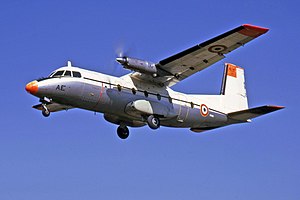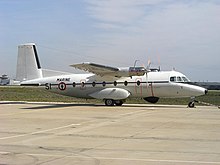| This article needs additional citations for verification. Please help improve this article by adding citations to reliable sources. Unsourced material may be challenged and removed. Find sources: "Aérospatiale N 262" – news · newspapers · books · scholar · JSTOR (January 2013) (Learn how and when to remove this message) |
| N 262 / Frégate | |
|---|---|
 Aerospatiale/Nord N 262D-51 Frégate, c/n 105, radio callsign F-RBAE, French Air Force Aerospatiale/Nord N 262D-51 Frégate, c/n 105, radio callsign F-RBAE, French Air Force | |
| General information | |
| Type | Turboprop airliner |
| National origin | France |
| Manufacturer | Aérospatiale |
| Primary users | French Air Force French Navy Allegheny Airlines |
| Number built | 110 |
| History | |
| Manufactured | 1962–1976 |
| Introduction date | 1964 |
| First flight | N 262: 24 December 1962 |
| Developed from | Nord 260 |
The Aérospatiale N 262 is a French twin-turboprop high-wing airliner built first by Nord Aviation (merged into Aérospatiale in 1970). The aircraft was also known as the Nord 262.
Design and development
In 1957, the French aircraft manufacturer Max Holste began work on a twin-engined utility transport aircraft to replace the Douglas DC-3/C-47 Skytrain. The prototype, the Max Holste MH.250 Super Broussard, was powered by two Pratt & Whitney Wasp radial engines and first flew on 20 May 1959. A second prototype, the MH.260, powered by Turbomeca Bastan turboprop engines flew on 29 July 1960. In 1959, state-owned Nord Aviation (later merged with Sud Aviation and renamed Aérospatiale) signed an agreement with Max Holste to market and help produce the MH.260. Financial problems at Max Holste, however, led to Nord taking on the whole programme, which included further development of the aircraft, while Max Holste concentrated on the production of light aircraft, and was renamed Reims Aviation.

While nine MH.260s were built, the type found no commercial buyers, and Nord redesigned the aircraft to have a pressurized cabin and to meet US airworthiness requirements. The new airliner, the Nord 262, was like the MH.260, a high-winged high-wing cantilever monoplane of all-metal construction, powered by two Turbomeca Bastan, and fitted with a retractable tricycle undercarriage, with the main wheels retracting into fuselage-mounted fairings. Pressurization brought a new circular-section fuselage, which normally was fitted with seats for 26 passengers, with a maximum capacity of 29 passengers.
The first prototype took to the skies for the first time on 24 December 1962 and the aircraft was exhibited at the June 1963 Paris Air Show. The aircraft received its French airworthiness certificate on 16 July 1964 and entered initial commercial service with Air Inter of France in September that year.
Four of the first aircraft 262A, 262B, 262C, and 262D were built, the first two fitted with Bastan IVC engines, while the C and D models were fitted with the higher-powered Bastan VIIC. Of these four aircraft, the latter two saw their first air time in July 1968. Most sales of the initial aircraft were not in the passenger field, but rather the military field. The 262D was the most popular and marketed as Frégate.
As for the American designation, the "Mohawk 298" airplanes were modified Nord 262s and first flew on 7 January 1975, equipped with Pratt & Whitney Canada PT6A-45 turboprops. Built in order to meet United States FAR 298 regulation, the modification of the aircraft was overseen by Mohawk Air Services and outsourced to Frakes Aviation. Allegheny Airlines was the initial operator of the aircraft.
Joel Krane, the chairman of the FOEB (Flight Operations Evaluation Board) determined that a common type rating could be issued for the Nord 262 and Mohawk 298. Appropriate differences training would be required for transitioning pilots.
Variants


- Max Holste MH.250 Super Broussard
- Prototype 17-seat transport first flown in 1959.
- Max Holste MH.260 Super Broussard
- 23 passenger production variant of the MH.250, ten ordered but not completed before development handed over to Nord Aviation.
- N 262
- Prototypes and initial production version
- N 262A
- Early standard production version (preceded by N 262B). Powered by Turbomeca Bastan VIC engines. Certified 15 March 1965 with first delivery to Lake Central Airlines on 17 August 1965.
- N 262B
- Initial production version for Air Inter, powered by two Bastan VIC turboprops. Four built, with first example flown 8 June 1964, certification 16 July 1964 and delivery 24 July 1964.
- N 262C Frégate
- Bastan VIIC engines and greater wingspan
- N 262D Frégate
- French Air Force version of N-262C
- N 262E
- A maritime patrol and training version used by the Aviation navale (French Navy).
- Mohawk 298
- Nine aircraft updated by Frakes Aviation for Allegheny Airlines between 1975 and 1978. Powered by Pratt & Whitney Canada PT6A-45 engines driving five-bladed propellers.
Operators

As of July 2011, a total of three Nord 262 aircraft remain in airline service with the following airlines:
- Equatorial International Airlines (1),
- International Trans Air Business (1)
- RACSA (1).
Former operators



- Aerovias
- Air Ceylon
- Air Florida Commuter (operated by National Commuter Airlines)
- Air Inter
- Air Madagascar
- Alisarda
- Allegheny Airlines (Mohawk 298 conversion)
- Altair Airlines
- B.C. Air Lines (acquired by Pacific Western Airlines)
- Cimber Air
- Crown Airways
- Dan-Air
- Delta Air Transport
- Filipinas Orient Airways
- Golden Gate Airlines (former Swift Aire aircraft)
- IFG Interregional Fluggesellschaft
- Indonesia Airlines
- Japan Domestic Airlines
- Lake Central Airlines
- Linjeflyg
- Malu Aviation
- Mohawk Air Service
- National Commuter Airlines (NATCOM) (operated both Nord 262 and Mohawk 298 aircraft in Air Florida Commuter feeder service)
- Pacific Western Airlines (former B.C. Air Lines aircraft)
- Pocono Airlines
- Queensland Pacific Airlines
- Ransome Airlines
- Rhein Air (Switzerland)
- Rousseau Aviation [fr]
- Scheduled Skyways (commuter air carrier based in Fayetteville, AR, USA)
- Swift Aire Lines (commuter air carrier based in San Luis Obispo, CA, USA)
- Tempelhof Airways
- TAT - Touraine Air Transport
- Trans Service Airlift
- Tunis Air
- Wideroe
Military operators
Specifications (Nord 262A)
Data from Jane's All The World's Aircraft 1965–66
General characteristics
- Crew: 2
- Capacity: 29 passengers
- Length: 19.28 m (63 ft 3 in)
- Wingspan: 21.90 m (71 ft 10 in)
- Height: 6.21 m (20 ft 4 in)
- Wing area: 55.0 m (592 sq ft)
- Aspect ratio: 8.72:1
- Airfoil: NACA 23016 at root, NACA 23012 (mod.) at tip
- Empty weight: 6,654 kg (14,670 lb)
- Max takeoff weight: 10,300 kg (22,708 lb)
- Fuel capacity: 2,000 L (530 US gal; 440 imp gal)
- Powerplant: 2 × Turbomeca Bastan VIC turboprops, 794 kW (1,065 shp) each (eshp)
- Propellers: 3-bladed Ratier-Figae FH.146 variable-pitch propellers, 3.20 m (10 ft 6 in) diameter
Performance
- Maximum speed: 385 km/h (239 mph, 208 kn)
- Cruise speed: 360 km/h (220 mph, 190 kn) (econ cruise)
- Stall speed: 128 km/h (80 mph, 69 kn) (wheels and flaps down)
- Never exceed speed: 498 km/h (309 mph, 269 kn)
- Range: 1,110 km (690 mi, 600 nmi) (max fuel, 2,010 kg (4,430 lb) payload)
- Service ceiling: 7,300 m (24,000 ft)
- Rate of climb: 6.4 m/s (1,250 ft/min)
- Takeoff distance to 10.5 m (35 ft): 1,200 m (4,000 ft)
- Landing distance from 15 m (50 ft): 1,100 m (3,500 ft)
See also
Related development
Aircraft of comparable role, configuration, and era
Related lists
References
Notes
- ^ Chillon, Dubois & Wegg 1980, p. 68
- ^ Stroud 1966, p. 171
- Chillon, Dubois & Wegg 1980, pp. 68–69
- Stroud 1966, pp. 172–173
- ^ Taylor 1965, p. 49
- ^ Stroud 1966, p. 173
- Taylor 1971, p. 39
- ^ Taylor 1976, p. 36
- Taylor 1976, p. 338
- "The Aerospatiale N-262 Fregate & Mohawk 298". Airliners.net. Retrieved 6 August 2011.
- "World Airliner Census 2011" (pdf). Flightglobal Insight, p. 6. Retrieved 20 August 2011.
- "Weather & Aviation Page - Delta Air Transport". www.skystef.be.
- Bucher, F.E.; Klee, U. (1977). JP Airline Fleets 77. Zurich Airport: Editions JP. p. 74.
- "World Airliner Census 2009" (pdf). Flight International, 18–24 August 2009, p. 37.
Bibliography
- Chillon, Jacques; Dubois, Jean-Pierre & Wegg, John (1980). French Post-War Transport Aircraft. Tonbridge, UK: Air-Britain. ISBN 0-85130-078-2.
- Stroud, John (1966). European Transport Aircraft since 1910. London: Putnam.
- Taylor, John W. R., ed. (1965). Jane's All The World's Aircraft 1965–1966. London: Sampson Low, Marston & Company.
- Taylor, John W. R., ed. (1971). Jane's All The World's Aircraft 1971–1972. London: Jane's Yearbooks. ISBN 0-354-00094-2.
- Taylor, John W. R., ed. (1976). Jane's All The World's Aircraft 1976–1977. London: Jane's Yearbooks. ISBN 0-354-00538-3.
External links
| Société nationale de constructions aéronautiques du Nord (SNCAN)/Nord Aviation aircraft | |||||||||||||||||||
|---|---|---|---|---|---|---|---|---|---|---|---|---|---|---|---|---|---|---|---|
| Manufacturer designations | |||||||||||||||||||
| By role |
| ||||||||||||||||||
| Sud Aviation/Aérospatiale aircraft | |||||
|---|---|---|---|---|---|
| Fixed-wing aircraft | |||||
| Helicopters | |||||
| Other products |
| ||||
| See also: SOCATA aircraft | |||||